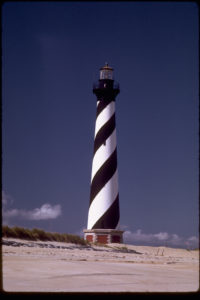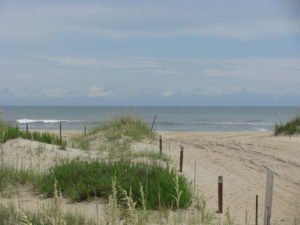On August 17, 1937, President Franklin Roosevelt signed into law an act that established the Cape Hatteras National Seashore. Although created by this law, the park did not actually come into existence until the mid-1950s, when enough land had been acquired to merit the area’s designation as a functioning National Park Service facility.

Cape Hatteras National Seashore occupies a portion of the Outer Banks of North Carolina. The Outer Banks are a series of barrier islands extending from southern Virginia along most of the North Carolina coastline, more than 200 miles in extent. The islands—and the submerged sand bars extending far into the ocean—are in constant motion, driven by the collision of warm waters of the Gulf Stream and cooler waters coming from the north. Because of the treacherous navigation caused by the changing sea-floor, this area is also known as the Graveyard of the Atlantic and is lined with historic lighthouses and facilities of the U.S. Coast Guard.
As the area became increasingly popular for tourism in the early decades of the 20th Century, concern grew that soon the dramatic beauty and natural resources that had drawn people to the shore would be lost to uncontrolled commercial development. A wildlife and outdoor artist, Frank Stick, began promoting the idea of a national coastal park in the 1930s. Stick was also a real estate broker, and he convinced a wealthy industrialist, Henry Phipps, to donate land to kick-start a park. Similar donations and land acquisition by the North Carolina state government gathered momentum, leading to the designation of the park in 1937.

Cape Hatteras National Seashore became the first beach property in the National Park Service. The necessity for such parks was expressed by Secretary of the Interior Harold Ickes in 1938:
When we look up and down the ocean fronts of America, we find that everywhere they are passing behind the fences of private ownership. The people can no longer get to the ocean. When we have reached the point that a nation of 125 million people cannot set foot upon the thousands of miles of beaches that border the Atlantic and Pacific Oceans, except by permission of those who monopolize the ocean front, then I say it is the prerogative and the duty of the Federal and State Governments to step in and acquire, not a swimming beach here and there, but solid blocks of ocean front hundreds of miles in length. Call this ocean front a national park, or a national seashore, or a state park or anything you please—I say that the people have a right to a fair share of it.
The park’s creation was one element of President Roosevelt’s “New Deal.” It provided work for thousands of young men as part of the Civilian Conservation Corps. A major ongoing project for the CCC was to control beach erosion; they erected fences above the high-tide line that captured blowing sand to form dunes, then they planted those dunes with grasses to stabilize the shoreline. Unlike most western parks at the time, Cape Hatteras National Seashore emphasized the economic development associated with tourism and contained roads and other facilities that allowed public access to beaches.
The park was officially created in 1953 and dedicated in 1958. It runs for 70 miles along the Outer Banks, covering 24,470 acres. The Pea Island National Wildlife Refuge, overseen by the U.S. Fish and Wildlife Service, lies within the park’s length, adding another 5,880 acres to the total of nationally preserved lands along the North Carolina coast. The park attracts over 2 million visitors per year.
The park addresses many dimensions of the National Park Service’s mission. First, of course, it preserves for the future one of the great landscapes of the continent. Second, it provides for use by the general public. Third, the park preserves a large variety of cultural and historic resources, including iconic lighthouses (the Cape Hatteras Lighthouse rises 208 feet, the highest in the nation). Fourth, the park is home to many protected species, including threatened sea-turtles that nest on the beaches. And, unlike most national park properties, waterfowl hunting is permitted.
References:
Angley, Wilson. 2006. Cape Hatteras National Seashore. NCpedia. Available at: http://www.ncpedia.org/cape-hatteras-national-seashore. Accessed August 16, 2017.
Binkley, Cameron. 2007. The Creation and Establishment of Cape Hatteras National Seashore. National Park Service. Available at: https://www.nps.gov/parkhistory/online_books/caha/caha_ah.pdf. Accessed August 16, 2017.
National Park Service. State of the Park Report—Cape Hatteras National Seashore. National Park Service. Available at: https://www.nps.gov/caha/learn/management/upload/CAHA_StateOfThePark.pdf. Accessed August 16, 2017.
National Park Service. Waterfowl Hunting. Cape Hatteras National Seashore, National Park Service. Available at: https://www.nps.gov/caha/planyourvisit/waterfowlhunting.htm. Accessed August 16, 2017.
